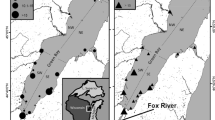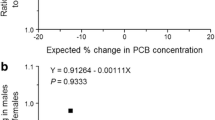Abstract
Whole-fish polychlorinated biphenyl (PCB) concentrations were determined for 25 female and 25 male burbot Lota lota from Lake Erie. Bioenergetics modeling was used to investigate whether the sex difference in growth rate resulted in a difference in gross growth efficiency (GGE) between the sexes. For ages 6–13 years, male burbot averaged 28 % greater PCB concentrations than female burbot. The sex difference in PCB concentrations widened for ages 14–17 years, with male burbot having, on average, 71 % greater PCB concentrations than female burbot. Bioenergetics modeling results showed that the faster growth rate exhibited by female burbot did not lead to greater GGE in female individuals of the younger burbot and that the faster growth by female fish led to female GGE being only 2 % greater than male GGE in older burbot. Although our bioenergetics modeling could not explain the observed sex difference in PCB concentrations, we concluded that a sex difference in GGE was the most plausible explanation for the sex difference in PCB concentrations of burbot ages 6–13 years. Not only are male fish likely to be more active than female fish, but the resting metabolic rate of male fish may be greater than that of female fish. We also concluded that the widening of the sex difference in PCB concentrations for the older burbot may be due to many of the older male burbot spending a substantial amount of time in the vicinity of mouths of rivers contaminated with PCBs.



Similar content being viewed by others
References
Altimiras J, Johnstone ADF, Lucas MC, Priede IG (1996) Sex differences in the heart rate variability spectrum of free-swimming Atlantic salmon (Salmo salar L.) during the spawning season. Physiol Zool 69:770–784
Beamish FWH (1964) Seasonal changes in the standard rate of oxygen consumption of fishes. Can J Zool 42:189–194
Borgmann U, Whittle DM (1992) Bioenergetics and PCB, DDE, and mercury dynamics in Lake Ontario lake trout (Salvelinus namaycush): a model based on surveillance data. Can J Fish Aquat Sci 49:1086–1096
Burgermeister G, Bedrani M, Tarradellas J (1983) Utilisation de la lotte comme indicateur de la pollution des eaux continentals pars des pollutants organochlorés. Eau Que 16:135–143
Coldwater Task Group (2012) Report of the Lake Erie Coldwater Task Group. Presented to the Standing Technical Committee, Lake Erie Committee of the Great Lakes Fishery Commission, Ann Arbor, 23 March 2012
Cooke SJ (2004) Sex-specific differences in cardiovascular performance of a centrarchid fish are only evident during the reproductive period. Funct Ecol 18:398–403
Draper NR, Smith H (1981) Applied regression analysis (2nd ed). Wiley, New York
Edwards WH, Stapanian MA, Stoneman AT (2011) An evaluation of precision in age estimation of two treatments of otoliths from an aging burbot population. J Appl Ichthyol 27(Suppl 1):43–48
Einhouse DW, Bur MT, Cornelius FC, Kenyon R, Madenjian CP, Rand PS et al (1999) Consumption of rainbow smelt by walleye and salmonine fishes in eastern Lake Erie. In: Munawar M, Edsall T, Munawar IF (eds) State of Lake Erie: past, present and future. Backhuys Publishers, Leiden, pp 291–303
Frame GM, Cochran JW, Boewadt SS (1996) Complete PCB congener distributions for 17 Aroclor mixtures determined by 3 HRGC systems optimized for comprehensive, quantitative, congener-specific analysis. J High Resolut Chromatogr 19:657–668
Hanson PC, Johnson TB, Schindler DE, Kitchell JF (1997) Fish bioenergetics 3.0. University of Wisconsin, WISCU-T-97-001, Madison
Hutchings JA, Gerber L (2002) Sex-biased dispersal in a salmonid fish. Proc R Soc Lond Ser B Biol Sci 269:2487–2493
Jackson LJ, Schindler DE (1996) Field estimates of net trophic transfer of PCBs from prey fishes to Lake Michigan salmonids. Environ Sci Technol 30:1861–1865
Jude DJ, Rediske R, O’Keefe J, Hensler S, Giesy JP (2010) PCB concentrations in walleyes and their prey from the Saginaw River, Lake Huron: a comparison between 1990 and 2007. J Great Lakes Res 36:267–276
Larsson P, Okla L, Collvin L (1993) Reproductive status and lipid content as factors in PCB, DDT, and HCH contamination of a population of pike (Esox lucius L.). Environ Toxicol Chem 12:855–861
Lucas MC, Johnstone ADF, Priede IG (1993) Use of physiological telemetry as a method of estimating metabolism of fish in the natural environment. Trans Am Fish Soc 122:822–833
Madenjian CP (2011) Sex effect on polychlorinated biphenyl concentrations in fish: a synthesis. Fish Fish 12:451–460
Madenjian CP, Carpenter SR, Rand PS (1994) Why are the PCB concentrations of salmonine individuals from the same lake so highly variable? Can J Fish Aquat Sci 51:800–807
Madenjian CP, Noguchi GE, Haas RC, Schrouder KS (1998) Sexual difference in polychlorinated biphenyl accumulation rates of walleye (Stizostedion vitreum). Can J Fish Aquat Sci 55:1085–1092
Madenjian CP, O’Connor DV, Nortrup DA (2000) A new approach toward evaluation of fish bioenergetics models. Can J Fish Aquat Sci 57:1025–1032
Madenjian CP, Bunnell DB, Gorman OT (2010) Ninespine stickleback abundance in Lake Michigan increases after invasion of dreissenid mussels. Trans Am Fish Soc 139:11–20
Madenjian CP, Stapanian MA, Witzel LD, Einhouse DW, Pothoven SA, Whitford HL (2011) Evidence for predatory control of the invasive round goby. Biol Invasions 13:987–1002
Masnado RG (1987) Polychlorinated biphenyl concentrations of eight salmonid species from the Wisconsin waters of Lake Michigan. Wisconsin Department of Natural Resources Fish Management Report No. 132, Madison
McPhail JD, Paragamian VL (2000) Burbot biology and life history. In: Paragamian VL, Willis DW (eds) Burbot: biology, ecology, and management. Publication No. 1. American Fisheries Society, Bethesda, pp 11–23
Muir DCG, Ford CA, Grift NP, Metner DA, Lockhart WL (1990) Geographic variation of chlorinated hydrocarbons in burbot (Lota lota) from remote lakes and rivers in Canada. Arch Environ Contam Toxicol 19:530–542
Niimi AJ (1983) Biological and toxicological effects of environmental contaminants in fish and their eggs. Can J Fish Aquat Sci 40:306–312
Ontario Ministry of Natural Resources (2012) 2011 Status of major stocks. Lake Erie Management Unit, London
Pääkkönen J-PJ, Rantalainen A-L, Karels A, Nikkilä A, Karjalainen J (2005) Bioaccumulation of PCBs in burbot (Lota lota L.) after delivery in natural food. Arch Environ Contam Toxicol 49:223–231
Preddice TL, Jackling SJ, Skinner LC (2002) Contaminants in young-of-year fish from near-shore areas of New York’s Great Lakes Basin, 1997. New York State Department of Environmental Conservation, Albany
Rudstam LG, Peppard PE, Fratt TW, Bruesewitz RE, Coble DW, Copes FA et al (1995) Prey consumption by the burbot (Lota lota) population in Green Bay, Lake Michigan, based on a bioenergetics model. Can J Fish Aquat Sci 52:1074–1082
Rypel AL, Findlay RH, Mitchell JB, Bayne DR (2007) Variations in PCB concentrations between genders of six warmwater fish species in Lake Logan Martin, Alabama, USA. Chemosphere 68:1707–1715
Schmidt LJ, Hesselberg RG (1992) A mass spectroscopic method for analysis of AHH-inducing and other polychlorinated biphenyl congeners and selected pesticides in fish. Arch Environ Contam Toxicol 23:37–44
Sheffy TB (1980) The PCB monitoring program in Wisconsin—surveillance strategy and use of data. In: Eaton JG, Parrish PR, Hendricks AC (eds) Aquatic toxicology, ASTM STP 707. American Society for Testing and Materials, Philadelphia, pp 155–163
Smith KL Jr, Brown NO (1983) Oxygen consumption of pelagic juveniles and demersal adults of the deep-sea fish Sebastolobus altivelis measured at depth. Mar Biol 76:325–332
Stapanian MA, Madenjian CP, Witzel LD (2006) Evidence that sea lamprey control led to recovery of the burbot population in Lake Erie. Trans Am Fish Soc 135:1033–1043
Stapanian MA, Madenjian CP, Tost J (2007) Regional differences in size-at-age in the recovering burbot population in Lake Erie. J Great Lakes Res 33(Suppl 1):91–102
Stapanian MA, Paragamian VL, Madenjian CP, Jackson JR, Lappalainen J, Evenson MJ et al (2010) Worldwide status of burbot and conservation measures. Fish Fish 11:34–56
Stow CA, Carpenter SR, Madenjian CP, Eby LA, Jackson LJ (1995) Fisheries management to decrease contaminant consumption. BioScience 45:752–758
Swackhamer DL, Trowbridge AG, Nater EA (1997) Standard operating procedure for the analysis of PCB congeners by GC/ECD and trans-nonachlor by GC/MS/ECNI. Lake Michigan mass balance study (LMMB) methods compendium. Vol 2: Organic and mercury sample analysis techniques, Chap 1, Section 042. United States Environmental Protection Agency, Great Lakes National Program Office, EPA 905-R-97-012b, Chicago
United States Fish and Wildlife Service (USFWS) (2002) Natural resource damage assessment plan for the Ashtabula River and Harbor. USFWS Region 3, Fort Snelling
Acknowledgments
The authors thank Larry Witzel, Andy Cook, and the Ontario Ministry of Natural Resources staff for catching the burbot in Lake Erie; Bill Edwards and Richard Krause for aging the burbot; Bill Edwards, Ellen George, Jaquie Craig, and Rich Quintal for assisting with the homogenization of burbot tissue; Larry Witzel for preparing the map; and Alan Steinman and Kurt Newman for reviewing the manuscript and making helpful suggestions for its improvement. Use of trade, product, or firm names does not imply endorsement by the United States Government. This article is Contribution 1746 of the United States Geological Survey Great Lakes Science Center.
Author information
Authors and Affiliations
Corresponding author
Rights and permissions
About this article
Cite this article
Madenjian, C.P., Stapanian, M.A., Rediske, R.R. et al. Sex Difference in Polychlorinated Biphenyl Concentrations of Burbot Lota lota From Lake Erie. Arch Environ Contam Toxicol 65, 300–308 (2013). https://doi.org/10.1007/s00244-013-9901-9
Received:
Accepted:
Published:
Issue Date:
DOI: https://doi.org/10.1007/s00244-013-9901-9




